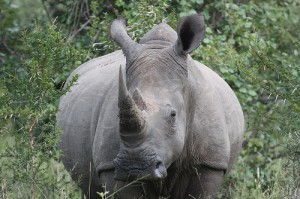Why Are Rhino Horns Twice as Valuable as Gold?
 Photo: rooymans2000
Photo: rooymans2000The price of gold has hit all-time highs recently, touching $1,800 an ounce as the stock market swooned last Wednesday. But there’s another commodity that’s enjoying an even bigger bull market these days: rhino horns. According to a recent study by Kenya-based ivory expert Esmond Martin, and his colleague Lucy Vigne, the ivory trade is hotter than ever, fueled by booming demand in China, where it is coveted for its supposed medicinal purposes. The study found that the number of ivory items on sale in southern China has more than doubled since 2004. And most of it is traded illegally.
As The Guardian’s Esther Addley recently reported, not only has the rising Chinese demand led to a surge in African poaching, but a sudden rise in thefts of antique rhino horns from European museums as well. Over the last six months there have been 20 thefts across Western Europe, and victims include the Royal Belgian Institute for Natural Sciences and the Educational Museum in Haslemere, Surrey.
Behind the crime wave is a surge in demand from the far east and European Asian communities for powdered rhino horn, which is used in traditional Chinese medicines. It is valued as a remedy for everything from fevers and headaches to cancer, and demand is so intense it has pushed the value of horn to £60,000 per kilogram – twice the value of gold.
The theft of antique rhino horns, however, seems quaint compared to the poaching that has accompanied a higher demand for rhino remedies. In another recent article in The Guardian, Greg Neale and James Burton report:
There has also been a dramatic surge in rhino poaching across Africa. The price of rhino horn has soared in the far east where it is used in alternative medicine as a cure for everything from nightmares to dysentery. In South Africa alone, where horn is worth more per gram than cocaine, the monitoring network “Traffic” reported that 333 rhinos were killed last year, and 193 in the first six months of this year. In 2007, only 13 rhinos were poached.
So is there any actual scientific evidence to the medicinal powers of rhino horns? Not really. From a 2008 Nature article:
In 1990, researchers at Chinese University in Hong Kong found that large doses of rhino horn extract could slightly lower fever in rats (as could extracts from Saiga antelope and water buffalo horn), but the concentration of horn given by a traditional Chinese medicine specialist are many many times lower than used in those experiments. In short, says Amin, you’d do just as well chewing on your fingernails.
And this 2010 National Geographic article does a nice job of laying out the extensive research that’s been done debunking the rhino-horn as medicine theory.

Comments